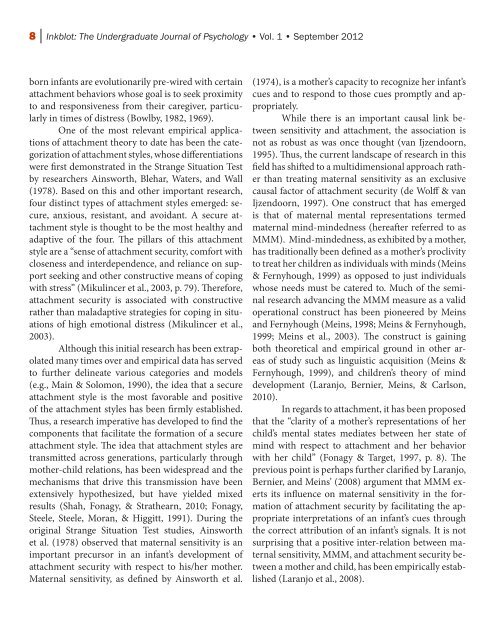7-17-Claire-Banga-Maternal-Mindedness
7-17-Claire-Banga-Maternal-Mindedness
7-17-Claire-Banga-Maternal-Mindedness
You also want an ePaper? Increase the reach of your titles
YUMPU automatically turns print PDFs into web optimized ePapers that Google loves.
8 | Inkblot: The Undergraduate Journal of Psychology • Vol. 1 • September 2012<br />
born infants are evolutionarily pre-wired with certain<br />
attachment behaviors whose goal is to seek proximity<br />
to and responsiveness from their caregiver, particularly<br />
in times of distress (Bowlby, 1982, 1969).<br />
One of the most relevant empirical applications<br />
of attachment theory to date has been the categorization<br />
of attachment styles, whose differentiations<br />
were first demonstrated in the Strange Situation Test<br />
by researchers Ainsworth, Blehar, Waters, and Wall<br />
(1978). Based on this and other important research,<br />
four distinct types of attachment styles emerged: secure,<br />
anxious, resistant, and avoidant. A secure attachment<br />
style is thought to be the most healthy and<br />
adaptive of the four. The pillars of this attachment<br />
style are a “sense of attachment security, comfort with<br />
closeness and interdependence, and reliance on support<br />
seeking and other constructive means of coping<br />
with stress” (Mikulincer et al., 2003, p. 79). Therefore,<br />
attachment security is associated with constructive<br />
rather than maladaptive strategies for coping in situations<br />
of high emotional distress (Mikulincer et al.,<br />
2003).<br />
Although this initial research has been extrapolated<br />
many times over and empirical data has served<br />
to further delineate various categories and models<br />
(e.g., Main & Solomon, 1990), the idea that a secure<br />
attachment style is the most favorable and positive<br />
of the attachment styles has been firmly established.<br />
Thus, a research imperative has developed to find the<br />
components that facilitate the formation of a secure<br />
attachment style. The idea that attachment styles are<br />
transmitted across generations, particularly through<br />
mother-child relations, has been widespread and the<br />
mechanisms that drive this transmission have been<br />
extensively hypothesized, but have yielded mixed<br />
results (Shah, Fonagy, & Strathearn, 2010; Fonagy,<br />
Steele, Steele, Moran, & Higgitt, 1991). During the<br />
original Strange Situation Test studies, Ainsworth<br />
et al. (1978) observed that maternal sensitivity is an<br />
important precursor in an infant’s development of<br />
attachment security with respect to his/her mother.<br />
<strong>Maternal</strong> sensitivity, as defined by Ainsworth et al.<br />
(1974), is a mother’s capacity to recognize her infant’s<br />
cues and to respond to those cues promptly and appropriately.<br />
While there is an important causal link between<br />
sensitivity and attachment, the association is<br />
not as robust as was once thought (van Ijzendoorn,<br />
1995). Thus, the current landscape of research in this<br />
field has shifted to a multidimensional approach rather<br />
than treating maternal sensitivity as an exclusive<br />
causal factor of attachment security (de Wolff & van<br />
Ijzendoorn, 1997). One construct that has emerged<br />
is that of maternal mental representations termed<br />
maternal mind-mindedness (hereafter referred to as<br />
MMM). Mind-mindedness, as exhibited by a mother,<br />
has traditionally been defined as a mother’s proclivity<br />
to treat her children as individuals with minds (Meins<br />
& Fernyhough, 1999) as opposed to just individuals<br />
whose needs must be catered to. Much of the seminal<br />
research advancing the MMM measure as a valid<br />
operational construct has been pioneered by Meins<br />
and Fernyhough (Meins, 1998; Meins & Fernyhough,<br />
1999; Meins et al., 2003). The construct is gaining<br />
both theoretical and empirical ground in other areas<br />
of study such as linguistic acquisition (Meins &<br />
Fernyhough, 1999), and children’s theory of mind<br />
development (Laranjo, Bernier, Meins, & Carlson,<br />
2010).<br />
In regards to attachment, it has been proposed<br />
that the “clarity of a mother’s representations of her<br />
child’s mental states mediates between her state of<br />
mind with respect to attachment and her behavior<br />
with her child” (Fonagy & Target, 1997, p. 8). The<br />
previous point is perhaps further clarified by Laranjo,<br />
Bernier, and Meins’ (2008) argument that MMM exerts<br />
its influence on maternal sensitivity in the formation<br />
of attachment security by facilitating the appropriate<br />
interpretations of an infant’s cues through<br />
the correct attribution of an infant’s signals. It is not<br />
surprising that a positive inter-relation between maternal<br />
sensitivity, MMM, and attachment security between<br />
a mother and child, has been empirically established<br />
(Laranjo et al., 2008).



